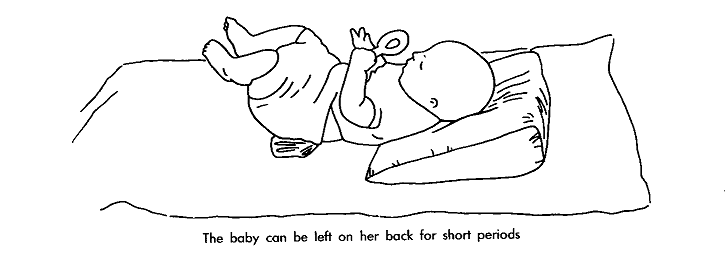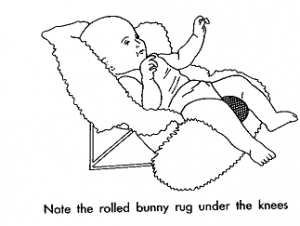GM.A.4 ATTEMPTS TO LIFT HEAD WHEN PULLED TO SIT FROM 45°
This is the third direction in which your child needs to control her head.
How to Assess
Method: Have your child leaning back (at about a 45° angle) on a firm surface, held by the hands. Pull her slowly to an upright sitting position. Score plus if your child makes any attempt to lift her head into line with the rest or her body.
How to teach
This skill may be very hard for floppy children to achieve and it will take many short practice sessions over many weeks for the baby to gain control over her head while the body is being lifted against gravity. Always place your child so that you can maintain eye contact with her as you practise this skill. You may find this easiest if your child sits on a table while you sit on a chair or on the floor position mentioned in the Positioning, Carrying and Playing section.
Support the child firmly around the shoulders. Rounding them slightly forward will help her to control her head. Keep your index fingers out straight, behind her neck, so that is she suddenly loses control, your fingers will be there to prevent her head from tipping back. Maintaining eye contact and talking to her constantly, slowly lower her backwards a few degrees, hold it for 5-8 seconds and then return her to the sitting position. It is most important that you should do this on an angle, first leaning her to one side, then to the other. as well as straight up and down. Repeat this several times, constantly talking to her. When she can control her head consistently at this level, try lowering her back a little further, up to a 45° angle. Continue to practise to whatever angle she can reliably maintain her head control.
Once you feel she can control her head when lowered from a sitting position to a 45° angle, then try pulling her up, starting at a 45° angle. Lean her back on pillows so that she is in a half-lying position at 45°, support her around the shoulders, rounding her shoulders forward with your hands. Then, telling her ‘sit’ or ‘up’, pull her slightly off the pillows and wait for her to attempt to lift her head, before you proceed with the movement.
Positioning, Carrying and Playing
For short periods only, place your baby on her back, with toys suspended over her. This would be a good time to remove her nappy so that she can kick without restriction. While your baby is on her back on the floor, it is wise to place a small pillow under her head and a small pillow or folded nappy under her buttocks. This will ensure that her spine and pelvis are kept in a position that will prepare her for a good posture and ‘normal’ movement.
She can also spend short periods in a baby chair. It is important to tuck a nappy or a bunny rug under her knees and thighs to hold her pelvis in a good position and to encourage her tummy muscles to work. Again, suspend toys where she can see and reach for them.
When you are holding her on your lap, chat to her and practise the skill of lowering her back to 45°, then encouraging her up again, all the time maintaining eye contact. Remember, tilt her back at an angle. Sit on the floor, your back supported by a firm surface and bend your knees so your thighs form a slope of about 45°. Place your baby on your thighs and again pull her up and lower her, supporting her around her shoulders, or if she can manage it, hold her upper arms or even her hands.


Continue carrying her with her arms forward, legs well bent, in the bunny rug in the crook of your arm; do not support her head. If you tilt her back very slightly, she will have to work to bring her head forward. Don’t tip her so far that her head falls right back. Continue to pick her up and place her down on her alternate sides.
